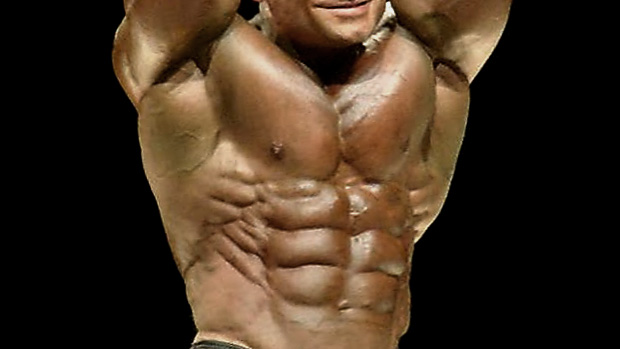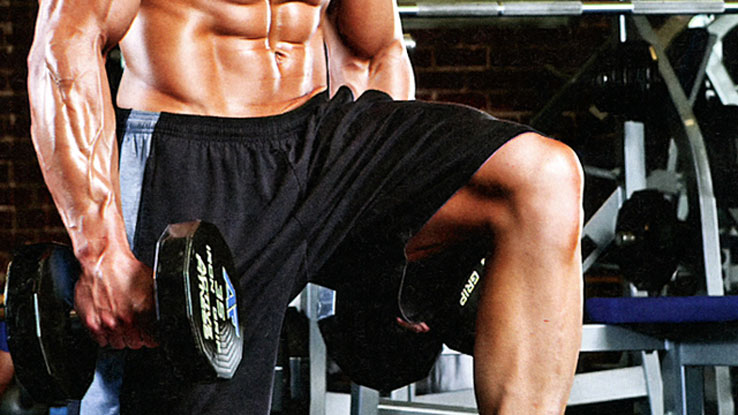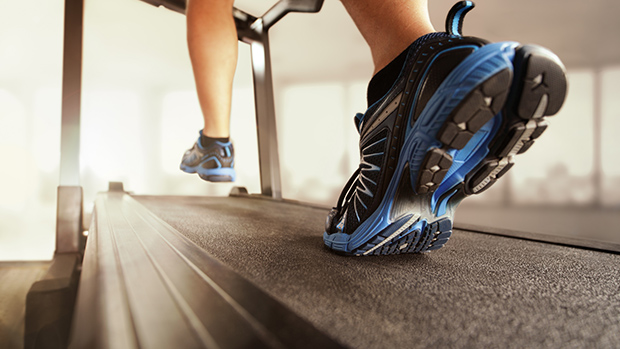More people are concerned about their midsection than any other body part. The core comprises roughly a third of the body, yet it never receives full attention in the gym. Sporting a great set of abs is high on anyone's list. Hey, if the core is in shape, the whole body is in shape!
The "want" is there, but the "how" is another story. There exists much confusion on how to train the abdominals properly. This article will dispel many of the myths and misconceptions regarding abdominal training. As you read on, take note on how many of these core issues you have fallen prey to.
Myth #1: Pressed-Heel Sit-Ups are the bomb as they eliminate hip flexor activation.

The Janda sit-up has recently resurfaced as an effective abdominal exercise minus the hip flexor activation. Janda thought he solved the problem of psoas activation by calling on the principle of reciprocal inhibition, which says that the nervous system, as a matter of efficiency, relaxes the muscles opposite the ones contracting.
The Janda sit-up was designed to inactivate the hip flexors by contracting the hamstrings and glutes. Janda thought he accomplished this by grasping subjects' calves and having them pull back against his hands as they attempted to sit-up. The theory was, the hip flexors are inhibited by the contraction of the opposing knee-flexor hamstrings and the hip-extensor glutes. The end result, according to Dr. Janda, is true isolation of the abdominal muscles.
Well, according to Dr. Stuart McGill, a spinal biomechanist and professor at the University of Waterloo, the opposite actually occurs!
During the Janda (or pressed-heel) sit-up, contraction of the hamstrings causes hip extension, which means that even greater hip flexion (or psoas activation) is required to complete the movement. In addition, bent-knee sit-ups actually activate the psoas more than straight leg sit-ups! This was all confirmed through EMG analysis by Juker, et al., 1998.
Solution: Can the Jandas, bent knee sit-ups and other posas-dominant activities in favor of more effective protocols (see below).
Myth #2: Traditional abdominal exercises work the abs through a full range of motion.

Not true. The primary function of the abdominals is to flex the trunk from 45 degrees of extension to 30 degrees of flexion. Most abdominal exercises, however, are performed either on the floor or on a decline bench, which is less than half of the range of motion (ROM).
Solution: To get at your abs in a full ROM, perform pre-stretch crunches on either a Swiss ball or an AbMat.
If you've been toying with these movements for a while and don't feel much benefit anymore, try what I call the Sicilian Crunch. (See the end of the article for instructions.) You must have a solid base of core training before attempting this advanced movement. It's one of those "let's play with the lever arm" type of exercises in which better leverage occurs during the weaker, concentric action and then all hell breaks loose during the stronger, eccentric action.
Unless you want to topple backward and send the Swiss ball flying into the juice bar, I'd suggest anchoring your feet under a sturdy support. Also, take advantage of the spherical nature of the Swiss ball or AbMat to achieve full range of motion.
Myth #3: We are the Hollow Men!
The popular act of drawing in the navel or "sucking in your gut as if you're putting on a tight pair of jeans" should definitely be abandoned; unless there's a specific reason to do so (i.e., motor re-education) as it tends to detract the emphasis from other muscles.
It is necessary to keep the core tight without the aid of a belt, but overemphasis on the transversus abdominis (or TVA for short, which is basically the internal girdle that keeps your organs from spilling out) can negatively affect performance.
The advice to activate the deep abdominal wall was well intentioned, but unfortunately you can't extrapolate information from a pathological population (i.e. low back-pain patients) and apply it to healthy individuals — it just doesn't work that way!
I tried this approach with several clients early in my career. The report from most of them was that it felt uncomfortable, almost as if their lungs were being pushed out of their throat while squatting. The body doesn't lie; if something doesn't feel right, don't do it!
I remember Olympic strength coach Charles Poliquin once commenting on this practice. "Why rob the neural drive from the extensor chain by drawing in the navel?" he asked. It didn't make sense to me, either.
Abdominal & lower back guru Dr. Stuart McGill recommends that you brace the abdominals — as if you're about to accept a punch — but don't suck 'em in if you want spinal stability. And after adopting this method with my own clients: no more complaints and performance started to improve.
Louie Simmons and Dave Tate of Westside Barbell (these guys are renowned for producing world-caliber strength athletes) have stated numerous times that if you want to increase core stability, do the opposite — push out your gut! Yet despite all the evidence against it, there are still coaches and personal trainers who continue to endorse abdominal hollowing on practically every movement. Ultimately, the decision is yours.
Solution: Don't suck in you gut; brace your abs.
Myth #4: To breathe or not to breathe. Is there even a question?
Should you hold your breath throughout a set? Or should you inhale during the eccentric portion of a lift, and exhale during the concentric? Or is it the other way around? Do the rules change if you suffer from chronic halitosis?
Forget about it. I think strength coach Charles Staley put it best when he stated that we breathe quite well by instinct alone. Messing around with this could negatively affect performance.
I never discuss so-called "proper breathing" when demonstrating an exercise because, like Staley, I feel that it detracts concentration and will negatively affect performance. It's hard enough trying to concentrate on technique, you just confuse people when you add special breathing instructions. Let it come naturally — you'll see that they will naturally hold their breath when they exert themselves.
Both McGill and Siff agree that the common recommendation of exhaling upon exertion (or raising of the weight) and inhaling on the lowering is a mistake. Much like the discussion of the TVA and abdominal hollowing, Siff states that the "careful instruction as to the technique of a given exercise will automatically result in the body responding with the optimal muscle recruitment strategy throughout the duration of the movement." This also applies to breathing. Let it occur naturally.
Solution: You have distractions in the gym; don't let breathing be another one.
Better Results Requires a Better Ab Workout
So now that we know the most common myths and misconceptions associated with abdominal training, let's get down to brass tacks and address what really matters.
Step 1: Get your upper and lower abs in order.
A classic argument is whether abdominals should be divided into upper and lower classifications. One camp says that they are one muscle — there is no such thing as an upper and lower part. However, research has shown that you can selectively recruit different segments of a muscle depending on the type of exercise you do, and how much weight is used.(Antonio, 2000)
The lower abdominals have the most complex recruitment patterns and are the weakest; whereas, the upper abdominals are much stronger and easier to train. Thus, perform your abdominal exercises in the following sequence:
- Lower Abdominals
- Obliques and Quadratus Lumborum
- Upper Abdominals
Step 2: Take advantage of the abdominals' role as stabilizers.
If you want to build a serious set of abdominals, routinely perform the following exercises and their variations: squats, deadlifts, chin-ups and standing military presses. These multi-joint movements require a strong contribution from the abdominals to stabilize the core, particularly when heavy loads are used. It is not uncommon to hear people complain of abdominal soreness a day or two after performing multiple sets with a decent weight of the chin-up or standing military press exercise — the pre-stretch will tap into fibers you never thought existed!
Your abdominals act as a natural girdle, or weight belt if you will, when performing all exercises, particularly squats and deadlifts. These muscles act as a bridge between your upper and lower body and are heavily recruited as stabilizers.
Isolation exercises like pullovers, curls, and even triceps pressdowns also require a good degree of core stability; however, the loads used are relatively low compared to the big 4 mentioned above. In fact, isolation becomes virtually impossible if large loads are used and, in many cases, the tension developed in the stabilizers will equal or even exceed that of the prime movers! So, you see, the abdominals can be trained quite effectively indirectly as stabilizers. The physiques of top Olympic weightlifters will attest to that.
Step 3: Train right for your fiber type.
If you've been doing tons of reps of wimpy little abdominal exercises like you're auditioning for Caribbean workout, then it's no wonder that you're stuck in a rut. The abdominals are composed of primarily Type II or fast-twitch (FT) fibers. The Rectus Abdominus, the so-called "six-pack" muscle, is comprised of 54% FT fibers. (Colling, 1997) Here's what I suggest to really tap into these high threshold fibers:
- pick big (i.e., multi-joint, compound) movements
- train in a full range of motion (get the prestretch)
- perform explosive concentric and slow eccentric actions
- do many sets of low reps using heavy loads
- make sure you get enough rest between sets
Putting It All Together—The Enlightened Man's Ab Routine.
You get all that? Well, it was only three steps; so if I did lose you, it also likely takes you three hours to make minute rice. Next time try doubling your Power Drive® dosage before logging onto T NATION.
Anyway, the following is a sample routine that will target your abdominals effectively and efficiently. No more 50 rep sets for you — it's time to start training your core like the ferocious little fast twitch muscles they are.
A1. Lean-Away Chin-Ups 6 x 1-3 @ 5-0-X-0, 120 secs.
Add weight to chin/dip belt, clear chin at top, lean back as you come down by pushing the bar away and make sure to go all the way down at the bottom.
A2. Standing Military Press 6 x 1-3 @ 5-0-X-0, 120 secs.
Clean the weight up to your shoulders, stand with your legs straight (yes, that means knees locked) and arch your back slightly to maximize pre-stretch.
B1. Dragon Flag 4-6 x 4-6 @ 5-0-X-0, 90 secs.
This is similar to the move in Rocky IV, minus the ambience that training in a barn in Siberia can only provide. Yelling "Drago!" between reps adds to the training effect.
Lie on your back on the exercise bench. Your lower body should extend off the bench so that your entire body remains in a straight line. Bend your elbows over your head and grasp the sides of the bench with your hands. Your neck and spine should be aligned and you should be looking directly upward toward the ceiling.
Raise your entire lower body upward toward the ceiling. You can point your toes and keep both of your legs as straight as possible. When you reach a vertical position, do not extend your legs any farther. At this point they should be perpendicular to the ceiling and the floor.
Tense your abdominal muscles. Hold them this way while maintaining your elevated position. To stay balanced, your body will need your abs to remain very tight.
Lower your body back to its original position. To make the exercise harder, stop just short of allowing your lower body to touch the bench. Do not allow gravity to pull your body quickly back to the ground, but rather use your abdominal muscles to gently lower your legs.
B2. Sicilian Crunch 4-6 x 4-6 @ 5-0-X-0, 90 secs.
Laying supine on a Swiss ball, keep a dumbbell high on your chest as you crunch upward. At the top of the movement when you are sitting upright, extend your arms straight overhead with the dumbbell. Make sure that you have a good grip on it—if the dumbbell slips onto your head, it could ruin the set (and your haircut). Then, slowly control the movement downward.
Keep your arms slightly bent and in line with your torso while lowering. It should feel like every fiber of your abdominals is ripping apart! Enjoy that feeling as you perform five sets of 4-6 reps at a 5010 tempo (i.e., 5 seconds to lower, no pause at the bottom, 1 second to raise and no pause at the top), taking three minutes to rest in between each set. Try to keep the total time under tension below 40 seconds and really exaggerate the eccentric action in a slow, smooth, controlled manner.

If you would like to finish off with a couple of sets of Ab wheel rollouts for as many reps as possible, be my guest. Make sure to work the legs and back/hip extensors during another workout. Rolling out of bed the next day should offer an unpleasant surprise!
Nothing in strength training is engraved in stone, but if you want your abs to look like they were chiseled out of rock, be inquisitive. There exist far more myths and misconceptions about abdominal training than any other body part. To find the real answers, you must address the core issues!
References
Antonio, J. Nonuniform response of skeletal muscle to heavy resistance training: can bodybuilders induce regional hypertrophy? J. Strength Cond. Res. 14(1):102-113. 2000.
Askem, JV. The Romanian Deadlift.
Barron, J. Lessons from the Miracle Doctors – A Step-by-Step Guide to Optimum Health And Relief from Catastrophic Illness (E-book).
Casler, J. Abdominal Hollowing continues! Supertraining Group, 2003.
Chek, P. Benching and Breathing. Weight Training Posts (compiled by Tom Griffin), 1997.
Chek, P. Scientific core conditioning correspondence course. C.H.E.K. Institute. 1998.
Colling, R. Distribution of Human Muscle Fibre Type. Exercise Physiology 552, 1997.
Cresswell AG, Blake PL, Thorstensson A. The effect of an abdominal muscle training program on intra-abdominal pressure. Scand J Rehabil Med. 1994 Jun;26(2):79-86.
Dickerman RD, McConathy WJ, Smith GH, East JW, Rudder L. Middle cerebral artery blood flow velocity in elite power athletes during maximal weight-lifting. Neurol Res. 2000 Jun;22(4):337-40.
Goldenberg, L. Strength Training Q&A. Ironman Magazine. June 2000, Vol. 59, No. 6, pg. 150.
Juker D., McGill, S., Kropf P., & Steffen T. (1998) Quantitative intramuscular myoelectric activity of lumbar portions of psoas and the abdominal wall during a wide variety of tasks. Med Sci Sports Exerc. 30: 301-310
McGill, SM. Achieving Spine Stability: Blending Engineering And Clinical Approaches. 4th Interdisciplinary World Congress on Low Back Pain & Pelvic Pain. Montreal, Nov. 2001.
McGill, SM. Enhancing Low Back Health Through Stabilization Exercise.
Fitness Leader Guide
McGill SM. Low back exercises: evidence for improving exercise regimens. Phys Ther. 1998 Jul;78(7):754-65. Review.
McGill, SM. Low Back Injury: Improving Prevention Strategies and Rehabilitation Approaches. Ontario Kinesiology Association Seminar, 2001.
Narloch JA, Brandstater ME. Influence of breathing technique on arterial blood pressure during heavy weight lifting. Arch Phys Med Rehabil. 1995 May;76(5):457-62.
O'Connor P, Sforzo GA, Frye P. Effect of breathing instruction on blood pressure responses during isometric exercise. Phys Ther. 1989 Sep;69(9):757-61.
Siff, MC. Abdominal Hollowing vs Lifting Practice. Supertraining Group, 2003.
Siff, MC. Breathing Technique. Supertraining Group, 2002.
Siff, MC., Verkhoshansky, YV. Supertraining 4th Edition. Denver, CO: Supertraining International, 1999.
Supertraining Forum (originally moderated by Dr. Mel Siff).
Zatsiorsky, VM. Science and Practice of Strength Training. Champaign, IL: Human Kinetics, 1995.





